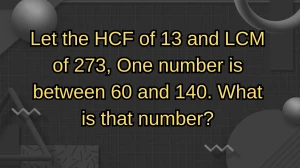A B and C can do a piece of work in 20, 30 and 60 days respectively. In how many days A can do the work if he is assisted by B and C on every third day?
by
Updated Jun 04, 2024

A B and C can do a piece of work in 20, 30 and 60 days respectively. In how many days A can do the work if he is assisted by B and C on every third day?
A, B, and C can complete a piece of work in 20, 30, and 60 days, respectively. This tells us about their work efficiencies. A is the most efficient, followed by B and then C.
Efficiency Calculation:
Efficiency is inversely proportional to time taken. Therefore, the efficiency of A, B, and C can be represented as 1/20, 1/30, and 1/60, respectively. This means A can complete 1/20th of the work in one day, B can complete 1/30th, and C can complete 1/60th.
A can complete 1/20th of the work in one day (Efficiency = 1/20).
B can complete 1/30th of the work in one day (Efficiency = 1/30).
C can complete 1/60th of the work in one day (Efficiency = 1/60).
Work Distribution:
Initially, A works alone for two days, completing 1/20th of the work each day. On the third day, A is assisted by B and C. Together, they complete 1/20th + 1/30th + 1/60th of the work on the third day.
On the first two days, A completes 2 * (1/20) = 1/10th of the work.
On the third day, A is assisted by B and C, and together they complete 1/20 + 1/30 + 1/60 = 1/10th of the work.
Calculating Completion Time:
By adding their daily efficiencies on the third day, we get 1/10th of the work done. Since they complete 1/10th of the work every third day, it takes 3 days for them to complete 1/5th of the work (1/10th * 3). Therefore, in 15 days, they can complete the entire work, as 15 days is the least common multiple (LCM) of their work completion times.
Efficient Work Completion:
The collaboration between A, B, and C on every third day optimizes the work completion process. A's higher efficiency, combined with the assistance from B and C, allows them to finish the work efficiently within 15 days.
Concept of Work Efficiency
When multiple individuals work together on a task, their combined efforts can often lead to more efficient completion of the work. In scenarios where people have different levels of efficiency or speed in completing tasks, collaboration can be strategically planned to optimize productivity.
In the context of work completion time calculations, such collaboration can significantly reduce the overall time required to finish a task. For instance, if individuals A, B, and C can complete a piece of work in 20, 30, and 60 days respectively, their individual efficiencies can be represented as fractions of the work completed per day.
By coordinating their efforts, such as having A work alone for two days and then being assisted by B and C on the third day, the work can progress more efficiently. This collaboration ensures that each person's strengths and efficiencies are utilized effectively to achieve the common goal of completing the work.
Mathematically, this collaboration involves calculating the combined efficiency of the team on days when they work together, determining the work completed during these collaborative days, and then to find the total time required to finish the entire task.
Method of Task Completion with Collaborative Work
Efficiency refers to how quickly and effectively individuals can complete tasks. In a collaborative work setting, understanding each team member's efficiency helps in allocating tasks effectively.
Collaboration Dynamics:
Collaboration involves team members working together towards a common goal. When individuals with varying levels of efficiency collaborate, it can lead to synergistic outcomes where tasks are completed more efficiently than if done individually.
Time Optimization:
Collaborative work allows for the optimization of time and resources. By using the strengths of each team member, tasks can be completed faster and with better quality.
Work Distribution:
Efficient task completion requires smart work distribution based on each team member's strengths and abilities. This involves assigning tasks in a way that maximizes overall productivity and minimizes idle time.
Calculating Completion Time:
Mathematical formulas can be used to calculate the time required to complete a task with collaborative work. This includes considering factors such as individual efficiencies, task complexity, and collaboration intervals.
Least Common Multiple (LCM):
The concept of LCM is crucial in determining efficient task completion intervals. By finding the LCM of individual completion times, teams can synchronize their efforts to achieve maximum efficiency.
Practical Application:
Real-world examples, such as project management scenarios or production processes, can demonstrate the benefits of collaborative work in achieving efficient task completion. These examples highlight how collaboration leads to improved outcomes compared to individual efforts.
Performance Analysis:
Analyzing the performance metrics of collaborative teams helps in understanding the impact of collaboration on overall task completion. Metrics such as productivity, quality of work, and time taken can be compared between collaborative and non-collaborative settings to assess the effectiveness of collaboration strategies.




